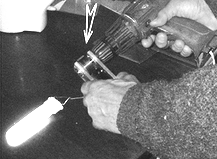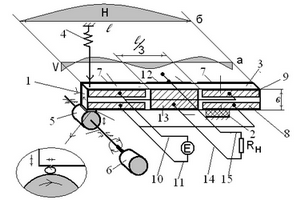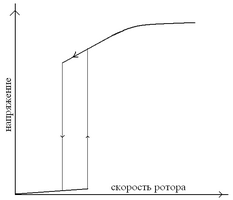Piezoelectric electric power generator
The hype in the world regarding the creation of piezoelectric energy sources until recently did not differ in the high level of inventive proposals. For example, Israeli scientists suggest mounting piezoelectric elements in the roadway and using the energy of passing cars. In Japan, the floor of one of the metro halls is covered with piezoelectric elements. These and similar projects of voltage generators do not withstand any criticism from an economic point of view. The reason is as follows.
For one click of an electric lighter, which lasts about 0.1 nanoseconds, more than 2 megawatts of power is released. That is, power per second is 0.2 watts. If you could make 1000 clicks per second, you would get 200 watts of power. Power is great, but how to make 1000 clicks per second. This is impossible, but it is possible to press the piezoelectric element to a smooth rotating wheel 20 or more thousand times, exciting ultrasonic vibrations in it.
This at least proves the following figure (Fig. 1). Thirty watts of power taken from the piezoelectric element (watts per gram of piezoelectric element) in a continuous mode at a voltage of 300 V was enough to power a fluorescent lamp. For this, the energy of a rotating wheel is converted into bending ultrasonic vibrations of a tuning fork made at one end of the Langevin package, and then, due to the piezoelectric effect, into high-frequency electrical vibrations.

That is, with the help of piezoelectric elements it is possible to create not only electric voltage generators, but also power generators.
The idea of using a piezoelectric motor as a power generator (Fig. 2) has been dispensed with for a long time. The reason is that, according to this idea, one type of oscillation must be forced to be excited in one of the parts of the piezoelectric element. This part will be called the pathogen. For this, in addition to mechanical impact, a separate power source is used. The second type of oscillation must be generated in another part of the piezoelectric element, due to the forced rotation of the rotor. We call this part of the piezoelectric element a generator.

Tests of prototypes confirmed the possibility of obtaining energy in the generator. But the power of the generator must be several times greater than the power taken from the power source of the pathogen. Otherwise, there is no point in such a generator. That's just how long it did not work.
Only relatively recently Vyacheslav Lavrinenko, the inventor of the piezoelectric motor, a pensioner, working at home after a careful selection of the materials of the piezoelectric element and contact pairs, was able to obtain useful power at the load several times more than the power taken from an additional power source. It became possible to direct part of the generator power to the pathogen and remove an additional source. He solved this problem in two ways.
In the first method, I measured the amplitude and phase at the inlet of the pathogen and, using reactive elements, adjusted the voltage at the generator output to the same amplitude and phase. That is, as in conventional electric generators, the conditions of the balance of the amplitude and phase were fulfilled. When these conditions were met, the exit closed with the entrance.
According to the second method, the voltage from the generator was converted into direct voltage, which fed the power amplifier and low-power alternating voltage generator. To the extent that we managed to consistently obtain useful power within 0.2 watts per gram of a piezoelectric element, Lavrinenko discovers an interesting effect that is comparable in physics with the discovery, which he formulated as follows:
That is, with the frictional interaction of the mentioned bodies, there is a positive feedback. The appearance of random vibrations form an ellipse, the dimensions of which increase with the rotation of the wheel. Similarly, in an electric voltage amplifier covered by positive feedback, electrical vibrations are spontaneously excited, and the energy of the constant voltage source is converted to alternating voltage. The dependence of this voltage on the rotation speed has the form shown in Fig. 3.

The discovered effect greatly simplifies the idea of creating piezoelectric power generators, and the power of 5 watts per gram of a piezoelectric element becomes quite real. Whether they will have advantages over electromagnetic generators can only be said over time, as they are studied, although some of them can be discussed now.
The lack of copper and windings - this is reliable in conditions of high humidity. The absence of heavy metals (copper and iron alloys) are high specific parameters. The high-frequency signal received at the output is easily transformed to any load. And the main advantage is that for any wheel speed a gearbox is not required. It is enough to correctly calculate the diameter of the wheel.
If it is not possible to use solar panels, piezoelectric power generators using energy, muscle or wind can replace them, for example, to charge batteries for laptops, tablets, etc. Although the relevance of the direction is obvious, sufficient financial support is required for its development, which, like many projects of our countries, not yet.
For one click of an electric lighter, which lasts about 0.1 nanoseconds, more than 2 megawatts of power is released. That is, power per second is 0.2 watts. If you could make 1000 clicks per second, you would get 200 watts of power. Power is great, but how to make 1000 clicks per second. This is impossible, but it is possible to press the piezoelectric element to a smooth rotating wheel 20 or more thousand times, exciting ultrasonic vibrations in it.
This at least proves the following figure (Fig. 1). Thirty watts of power taken from the piezoelectric element (watts per gram of piezoelectric element) in a continuous mode at a voltage of 300 V was enough to power a fluorescent lamp. For this, the energy of a rotating wheel is converted into bending ultrasonic vibrations of a tuning fork made at one end of the Langevin package, and then, due to the piezoelectric effect, into high-frequency electrical vibrations.

That is, with the help of piezoelectric elements it is possible to create not only electric voltage generators, but also power generators.
The idea of using a piezoelectric motor as a power generator (Fig. 2) has been dispensed with for a long time. The reason is that, according to this idea, one type of oscillation must be forced to be excited in one of the parts of the piezoelectric element. This part will be called the pathogen. For this, in addition to mechanical impact, a separate power source is used. The second type of oscillation must be generated in another part of the piezoelectric element, due to the forced rotation of the rotor. We call this part of the piezoelectric element a generator.

Tests of prototypes confirmed the possibility of obtaining energy in the generator. But the power of the generator must be several times greater than the power taken from the power source of the pathogen. Otherwise, there is no point in such a generator. That's just how long it did not work.
Only relatively recently Vyacheslav Lavrinenko, the inventor of the piezoelectric motor, a pensioner, working at home after a careful selection of the materials of the piezoelectric element and contact pairs, was able to obtain useful power at the load several times more than the power taken from an additional power source. It became possible to direct part of the generator power to the pathogen and remove an additional source. He solved this problem in two ways.
In the first method, I measured the amplitude and phase at the inlet of the pathogen and, using reactive elements, adjusted the voltage at the generator output to the same amplitude and phase. That is, as in conventional electric generators, the conditions of the balance of the amplitude and phase were fulfilled. When these conditions were met, the exit closed with the entrance.
According to the second method, the voltage from the generator was converted into direct voltage, which fed the power amplifier and low-power alternating voltage generator. To the extent that we managed to consistently obtain useful power within 0.2 watts per gram of a piezoelectric element, Lavrinenko discovers an interesting effect that is comparable in physics with the discovery, which he formulated as follows:
In two resonators of mutually perpendicular acoustic vibrations combined in one body with resonance frequencies offset from each other to create a phase shift between the vibrations when they are excited, mutually transverse vibrations are generated at a frequency between the resonant frequencies during frictional interaction of the body with another body, for example with a spinning wheel.
That is, with the frictional interaction of the mentioned bodies, there is a positive feedback. The appearance of random vibrations form an ellipse, the dimensions of which increase with the rotation of the wheel. Similarly, in an electric voltage amplifier covered by positive feedback, electrical vibrations are spontaneously excited, and the energy of the constant voltage source is converted to alternating voltage. The dependence of this voltage on the rotation speed has the form shown in Fig. 3.

The discovered effect greatly simplifies the idea of creating piezoelectric power generators, and the power of 5 watts per gram of a piezoelectric element becomes quite real. Whether they will have advantages over electromagnetic generators can only be said over time, as they are studied, although some of them can be discussed now.
The lack of copper and windings - this is reliable in conditions of high humidity. The absence of heavy metals (copper and iron alloys) are high specific parameters. The high-frequency signal received at the output is easily transformed to any load. And the main advantage is that for any wheel speed a gearbox is not required. It is enough to correctly calculate the diameter of the wheel.
If it is not possible to use solar panels, piezoelectric power generators using energy, muscle or wind can replace them, for example, to charge batteries for laptops, tablets, etc. Although the relevance of the direction is obvious, sufficient financial support is required for its development, which, like many projects of our countries, not yet.
